The Ultimate Guide to Dandelion Tunnel Microwave Sterilization Dryer in 2024
Introduction
In 2024, the Dandelion Tunnel Microwave Sterilization Dryer emerges as a pioneering solution in the realm of food processing technology. This advanced equipment combines the power of microwave sterilization with the efficiency of drying, offering unprecedented benefits for the preservation and enhancement of dandelion products. As consumer demand for safe, high-quality food continues to rise, the significance of innovative technologies like the Dandelion Tunnel Microwave Sterilization Dryer cannot be overstated. This guide delves into the intricacies of this cutting-edge machine, exploring its operational mechanisms, advantages, applications, and future prospects.

Working principle
The working principle of the Dandelion Tunnel Microwave Sterilization Dryer involves utilizing microwave technology to simultaneously sterilize and dry dandelion plants in a controlled tunnel environment. The dryer consists of a tunnel-like chamber where dandelion plants are conveyed through on a continuous belt system. Inside the chamber, microwave radiation is emitted uniformly to penetrate the dandelion plants, effectively killing harmful microorganisms and pathogens while also removing excess moisture.
Microwave energy heats the water molecules present in the dandelion plants, causing them to vibrate rapidly and generate heat. This heat is distributed evenly throughout the plants, resulting in rapid and uniform drying. At the same time, the microwave radiation disrupts the cellular structure of microorganisms, rendering them inactive and sterilizing the dandelion plants.
The controlled tunnel environment of the dryer ensures that the sterilization and drying process is carried out efficiently and consistently. Temperature, humidity, and airflow are carefully regulated to optimize the drying and sterilization parameters for dandelion plants.
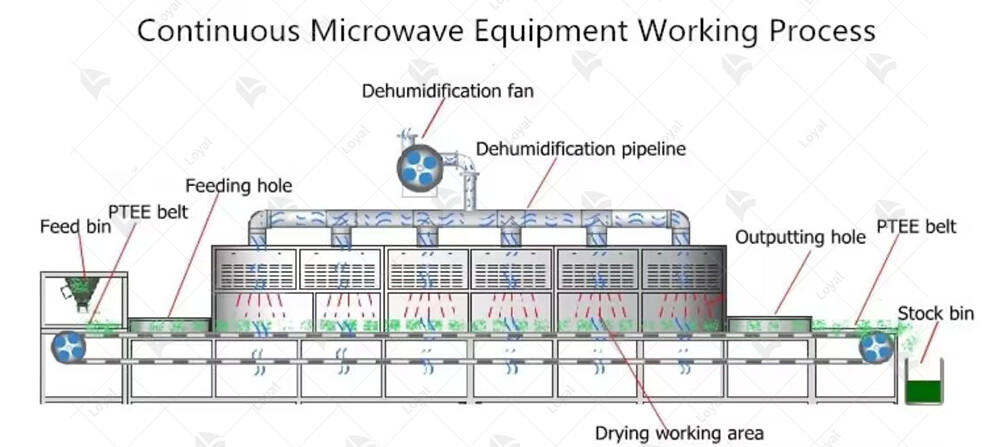
Advantages of microwave sterilizer
Advantages of Dandelion Tunnel Microwave Sterilization Dryer |
1. Efficiency:Microwave sterilization dryers offer rapid and uniform heating, leading to quicker processing times compared to conventional methods. |
2. Preservation of Nutritional Value:The gentle heating process of microwave sterilization helps preserve the nutritional integrity of dandelions, retaining vitamins, minerals, and antioxidants. |
3. Enhanced Safety:Microwave sterilization effectively eliminates harmful pathogens such as bacteria, viruses, and fungi, ensuring the safety and quality of dandelion products. |
4. Reduced Energy Consumption:Microwave technology requires less energy compared to traditional drying methods, resulting in lower operating costs and environmental impact. |
5. Improved Product Quality:By maintaining optimal moisture levels and preventing overheating, microwave sterilization dryers produce dandelion products with superior texture, color, and flavor. |
6. Versatility:Dandelion tunnel microwave sterilization dryers can be easily adjusted to accommodate different processing parameters, allowing for flexibility in product specifications. |
7. Space Efficiency:Compact and streamlined design of microwave sterilization dryers optimizes space utilization in processing facilities, maximizing production capacity. |
8. Automation Capability:Many microwave sterilization dryers feature advanced automation and control systems, minimizing manual intervention and ensuring consistent product quality. |
9. Compliance with Regulations:Microwave sterilization technology meets stringent food safety regulations and standards, providing assurance of product safety and compliance. |
10. Cost-Effectiveness:Despite initial investment costs, the long-term benefits of using a dandelion tunnel microwave sterilization dryer outweigh the expenses, leading to improved profitability over time. |
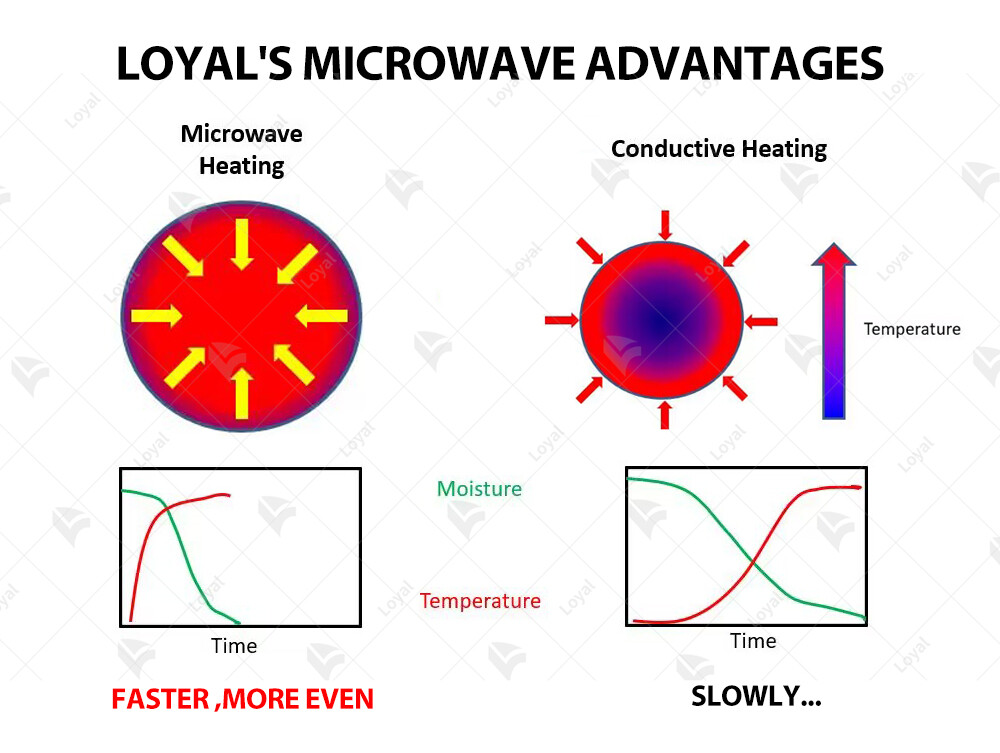
Key components of microwave sterilizer
Component | Description |
Microwave Generator | Generates microwave energy required for the sterilization and drying process. |
Waveguide | Transmits microwave energy from the generator to the processing chamber. |
Processing Chamber | Enclosed space where dandelions are subjected to microwave sterilization and drying. |
Conveyor Belt | Transports dandelions through the processing chamber, ensuring uniform exposure to microwave energy. |
Temperature Sensors | Monitors the temperature inside the processing chamber, ensuring optimal conditions for sterilization and drying. |
Humidity Control | Regulates the humidity levels within the processing chamber, optimizing the drying process and preventing moisture retention. |
Control Panel | Interface for operators to set parameters such as power levels, temperature, and processing time. |
Safety Features | Includes emergency stop buttons, interlocks, and alarms to ensure operator safety and prevent accidents during operation. |
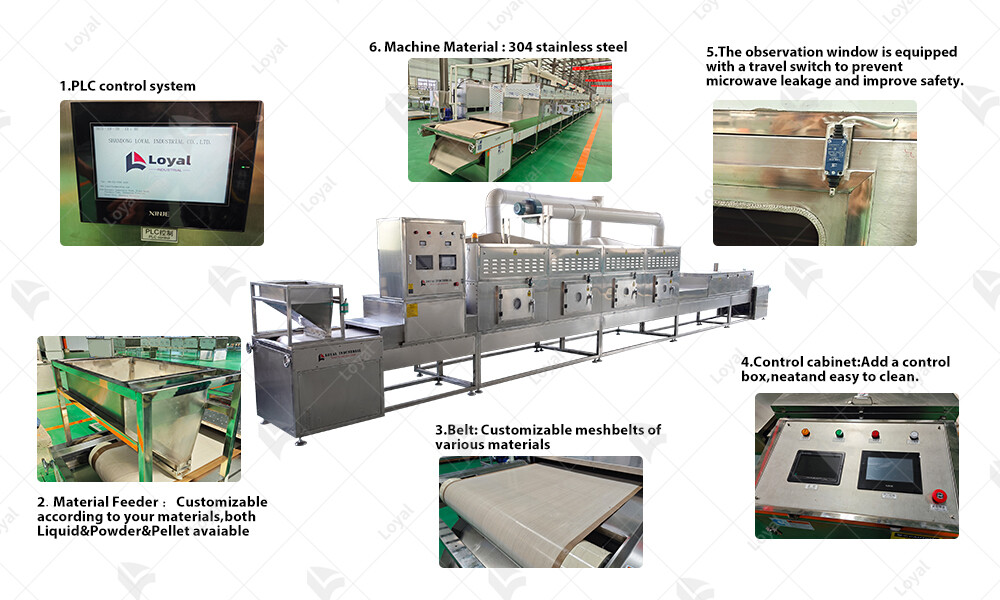
Comparison and advantages of microwave technology and traditional sterilization methods
Aspect | Microwave Sterilization Dryer | Traditional Sterilization Methods |
Sterilization Efficiency | High | Variable, may require longer processing times |
Time Efficiency | Rapid | Longer processing times |
Energy Consumption | Lower | Higher |
Preservation of Nutrients | Better | Potential degradation of nutrients |
Microbial Elimination | Effective against a wide range of microorganisms | May not effectively eliminate all types of microorganisms |
Environmental Impact | Lower emissions, no chemical residues | May require chemicals with environmental impact |
Equipment Cost | Initially higher investment, but may offer long-term cost savings | Lower initial investment, but ongoing costs may be higher |
Product Quality | Preserves flavor, color, and texture of dandelion | May result in changes to flavor, color, and texture |
Automation Potential | High, with advanced control systems and automation | Limited automation, may require manual monitoring |
Regulatory Compliance | Generally meets food safety standards | Compliance may vary, depending on the method and region |
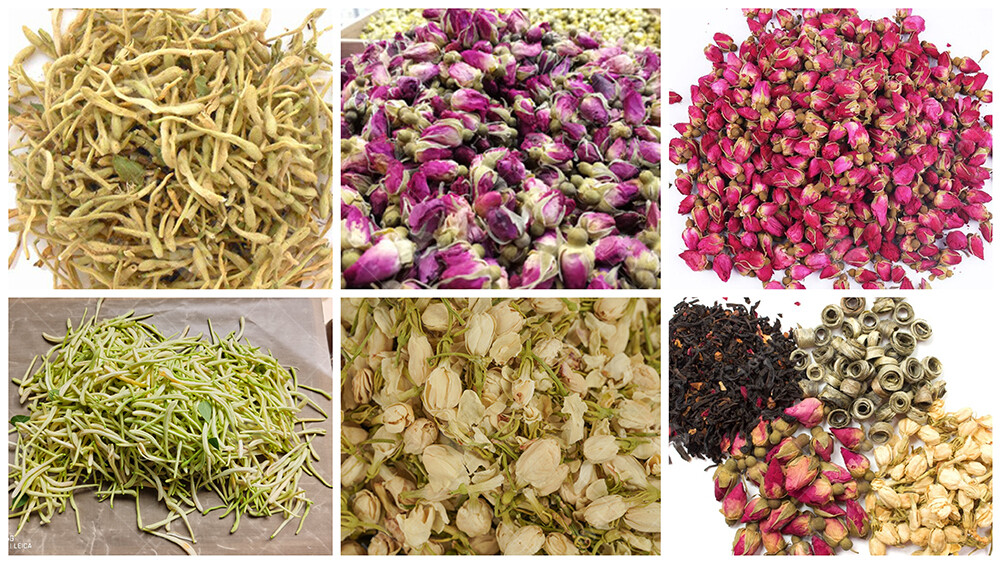
Technical parameters
| Technical Parameters Of Continuous Microwave Dryer Industrial Microwave Drying Machine | |||||
| Model | Size LWH(Can be customized according to the customer's requirements) | Output power | Dewaterability | Sterilization capacity | Baking and Roasting capacity (Depends on different raw material) |
| LY-10KW | 5000mm825mm1750mm | ≥10KW | 10KG/Hour | 100KG/Hour | 30-50KG/Hour |
| LY-20KW | 8000mm825mm1750mm | ≥20KW | 20KG/Hour | 200KG/Hour | 60-100KG/Hour |
| LY-30KW | 8500mm1160mm1750mm | ≥30KW | 30KG/Hour | 300KG/Hour | 90-150 KG/Hour |
| LY-40KW | 10000mm1160mm1750mm | ≥40KW | 40KG/Hour | 40KG/Hour | 120-200KG/Hour |
| LY-50KW | 12500mm1160mm1750mm | ≥50KW | 50KG/Hour | 500KG/Hour | 150-250KG/Hour |
| LY-60KW | 13500mm1450mm1750mm | ≥60KW | 60KG/Hour | 600KG/Hour | 180-300KG/Hour |
| LY-70KW | 13500mm1500mm1750mm | ≥70KW | 70KG/Hour | 700KG/Hour | 210-350KG/Hour |
| LY-80KW | 13500mm1650mm1750mm | ≥80KW | 80KG/Hour | 800KG/Hour | 240-400KG/Hour |
| LY-100KW | 16800mm1650mm1750mm | ≥100KW | 100KG/Hour | 1000KG/Hour | 300-500KG/Hour |
| LY-150KW | 22400mm1850mm1750mm | ≥150KW | 150KG/Hour | 1500KG/Hour | 450-750KG/Hour |
| LY-200KW | 27000mm1850mm1750mm | ≥250KW | 250KG/Hour | 2500KG/Hour | 750-1250/Hour |
| LY-300KW | 32000mm1850mm1750mm | ≥300KW | 300KG/Hour | 3000KG/Hour | 900-1500KG/Hour |
| Power Supply | 380V±10% 50Hz±1% Three-Phase Five-Wire | ||||
| Microwave Output Frequency | 2450±50Mhz | ||||
| Microwave Input Apparent Power | ≤168Kva | ||||
| Microwave Output Power | ≥120Kw | ||||
| Microwave Power Adjustment Range | 0-30Kw(Adjustable) | ||||
| Ambient Temperature | -5-40°C | ||||
| Relative Humidity | ≤80%, Surrounding Environment:No Corrosive Gas, Conductive Dust And Explosive Gas | ||||
| Transmission Speed | 0-10m/Min(Adjustable) | ||||
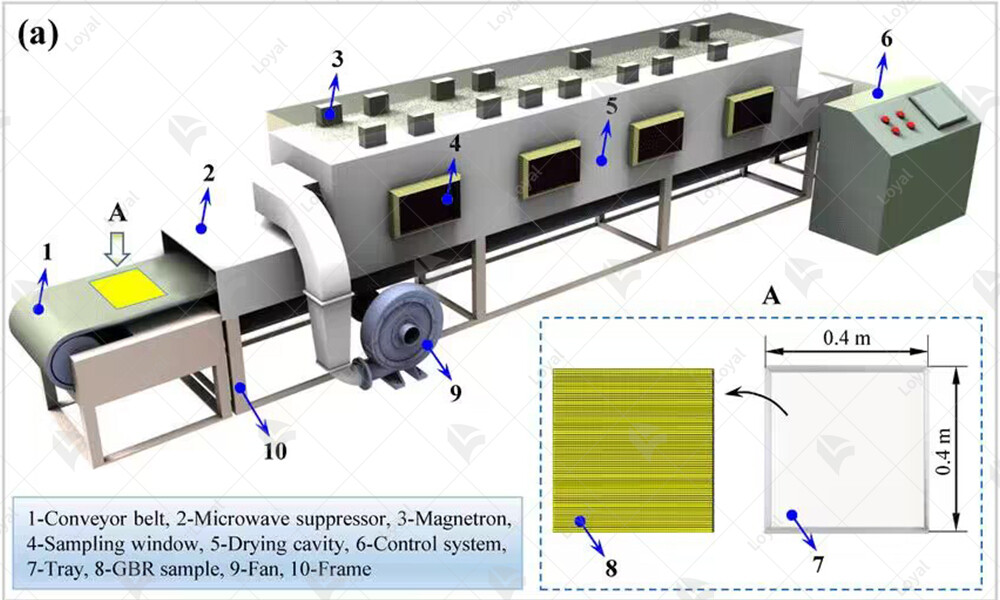
Technological progress and innovation of microwave sterilizers
In 2024, technological progress and innovation in microwave sterilizers have significantly enhanced the efficiency and effectiveness of food processing, particularly in the context of the dandelion tunnel microwave sterilization dryer.
Advanced Microwave Technology:
One of the key advancements in microwave sterilizers is the integration of advanced technology to improve performance and reliability. Newer models of sterilizers are equipped with enhanced microwave generators and distribution systems, ensuring uniform and thorough sterilization of dandelion and other food products.
Precision Control Systems:
Modern microwave sterilizers feature precision control systems that allow for accurate adjustment of sterilization parameters such as temperature, humidity, and exposure time. This level of control ensures optimal sterilization while minimizing the risk of over-processing or under-processing dandelion and other delicate food items.
Innovative Drying Capabilities:
In addition to sterilization, the latest microwave sterilizers are equipped with innovative drying capabilities that allow for efficient removal of moisture from dandelion and other foods. This not only extends the shelf life of the products but also helps to preserve their natural flavors, colors, and nutritional content.
Energy-Efficient Designs:
To address concerns about energy consumption and environmental sustainability, manufacturers have developed microwave sterilizers with energy-efficient designs. These machines utilize advanced insulation materials and optimized heating mechanisms to reduce energy waste and minimize carbon footprint during operation.
Integration of IoT and Automation:
Another notable trend in microwave sterilizers is the integration of Internet of Things (IoT) technology and automation features. These advancements allow for remote monitoring and control of sterilization processes, as well as predictive maintenance to prevent equipment downtime and optimize productivity.
Compliance with Regulatory Standards:
Furthermore, manufacturers of microwave sterilizers are increasingly focused on ensuring compliance with stringent food safety regulations and industry standards. This includes the implementation of robust quality assurance protocols, as well as regular testing and validation procedures to verify the effectiveness of sterilization and drying processes.
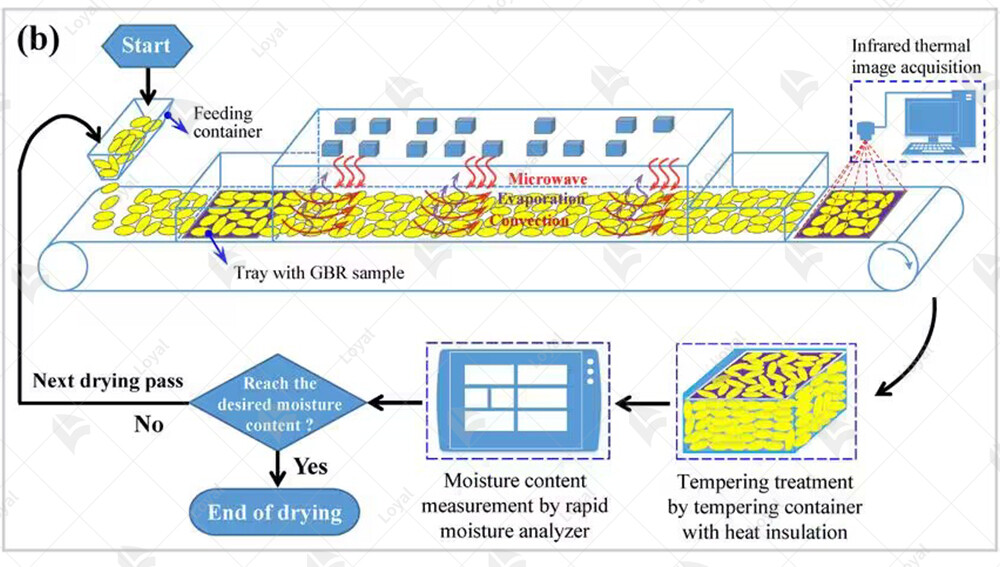
Precautions for selection and implementation of microwave sterilizers
When selecting and implementing a dandelion tunnel microwave sterilization dryer, there are several key precautions to consider to ensure optimal performance and safety.
1. Equipment Specifications:
Before making a selection, carefully review the specifications of the microwave sterilization dryer. Ensure that it is designed specifically for dandelion processing and meets the necessary capacity requirements for your production needs.
2. Microwave Technology:
Choose a sterilization dryer that utilizes advanced microwave technology. This ensures efficient and uniform heating throughout the dandelion tunnel, resulting in effective sterilization while preserving the nutritional quality and flavor of the dandelions.
3. Safety Features:
Prioritize safety features when selecting a microwave sterilization dryer. Look for features such as automatic shut-off mechanisms, temperature monitoring systems, and emergency stop buttons to prevent accidents and ensure operator safety during operation.
4. Regulatory Compliance:
Ensure that the selected microwave sterilization dryer complies with relevant regulatory standards and guidelines for food processing equipment. This includes certifications for food safety and quality assurance, as well as adherence to local health and safety regulations.
5. Installation and Training:
Proper installation and operator training are essential for the successful implementation of a dandelion tunnel microwave sterilization dryer. Work with experienced professionals to install the equipment correctly and provide comprehensive training for operators on its operation, maintenance, and safety protocols.
6. Maintenance and Service:
Establish a regular maintenance schedule for the microwave sterilization dryer to ensure continued performance and longevity. This includes routine inspections, cleaning, and calibration of equipment components, as well as prompt servicing of any issues or malfunctions that arise.
7. Process Optimization:
Optimize the sterilization process parameters to maximize efficiency and effectiveness. Experiment with different settings for power, temperature, and conveyor speed to achieve the desired level of sterilization while minimizing processing time and energy consumption.

Challenges and limitations of microwave sterilizers
Challenges and limitations of microwave sterilizers are important aspects to consider when evaluating their effectiveness and suitability for specific applications, such as the sterilization and drying of dandelions in a tunnel configuration.
1. Temperature Control:
Microwave sterilizers rely on precise temperature control to achieve effective sterilization and drying. However, maintaining consistent temperatures throughout the tunnel can be challenging, especially in larger-scale operations. Variations in temperature may result in uneven sterilization and drying, impacting the quality of the final product.
2. Uniformity of Sterilization:
Ensuring uniform sterilization across all dandelions in the tunnel is another challenge faced by microwave sterilizers. Dandelions located closer to the microwave source may receive higher levels of radiation, leading to over-sterilization, while those further away may not receive sufficient treatment, resulting in under-sterilization. Achieving uniformity of sterilization throughout the tunnel requires careful calibration and monitoring of microwave power levels.
3. Moisture Content Control:
Controlling moisture content during the sterilization and drying process is crucial for preserving the quality of dandelions. While microwave sterilizers offer the advantage of rapid heating, excessive moisture loss can occur if not properly regulated. Conversely, inadequate moisture removal may result in microbial growth and spoilage. Balancing moisture content to achieve the desired texture and shelf-life of the dried dandelions is a delicate process.
4. Energy Consumption:
Microwave sterilizers consume significant amounts of energy, particularly when operating continuously for extended periods. This can lead to high operational costs and environmental concerns related to energy usage. Finding ways to optimize energy efficiency without compromising sterilization efficacy is a constant challenge for operators of microwave sterilization dryers.
5. Equipment Maintenance:
Maintaining and servicing microwave sterilizers to ensure optimal performance is essential but can be labor-intensive and costly. Components such as magnetrons, waveguides, and conveyor systems require regular inspection, cleaning, and replacement to prevent breakdowns and ensure consistent sterilization results. Adequate training and resources for maintenance personnel are necessary to address these challenges effectively.
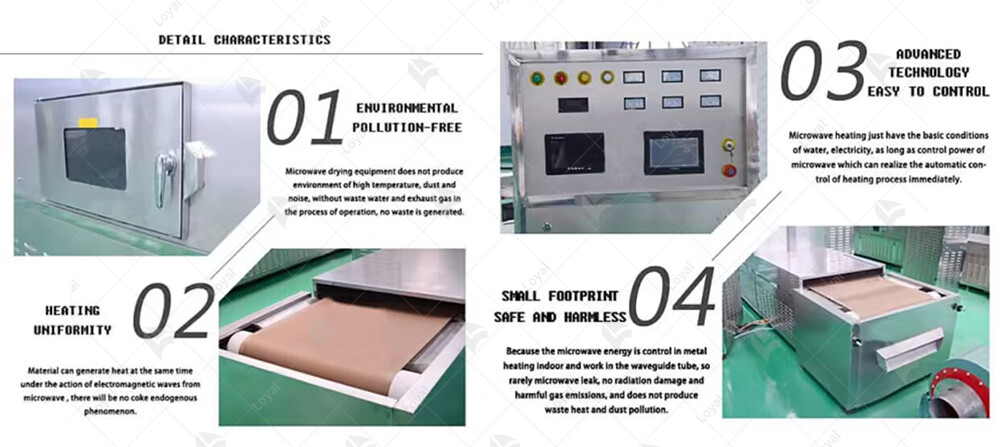
Post-maintenance of microwave sterilizers
Post-maintenance of microwave sterilizers is crucial to ensure their continued optimal performance and longevity. After prolonged use, it's essential to conduct regular maintenance to uphold food safety standards and preserve the quality of products like the dandelion tunnel microwave sterilization dryer.
Cleaning and Sanitization:
Thoroughly clean and sanitize all components of the microwave sterilizer, including the tunnel, conveyor belts, trays, and any other surfaces that come into contact with the dandelion products. Utilize approved cleaning agents and follow manufacturer guidelines to eliminate any residues or contaminants.
Inspection of Components:
Inspect all components of the microwave sterilizer for signs of wear, damage, or malfunction. Pay particular attention to seals, gaskets, and electrical connections, ensuring they are intact and functioning correctly. Replace any worn-out or damaged parts promptly to prevent leakage or operational issues.
Calibration and Adjustment:
Calibrate the microwave sterilizer according to manufacturer specifications. Adjust power levels, temperature settings, and conveyor speed to ensure consistent and effective sterilization and drying of dandelion products. Utilize calibrated instruments and adhere to standard procedures to achieve accurate results.
Testing and Validation:
Conduct testing and validation procedures to verify the performance of the microwave sterilizer post-maintenance. Run test cycles with controlled parameters and closely monitor the sterilization and drying process. Validate the effectiveness of the sterilization by testing samples of dandelion products for microbial load and quality attributes.
Documentation and Record-Keeping:
Maintain comprehensive records of all maintenance activities and testing results. Document cleaning schedules, component inspections, calibration adjustments, and validation tests. Keep detailed records to demonstrate compliance with food safety regulations and quality assurance standards.
Training and Education:
Provide training for operators and maintenance personnel on proper post-maintenance procedures for the microwave sterilizer. Ensure that staff members are familiar with the operation of the equipment and understand their responsibilities in maintaining its functionality and cleanliness. Ongoing education and training are critical for upholding food safety standards and optimizing machine performance.
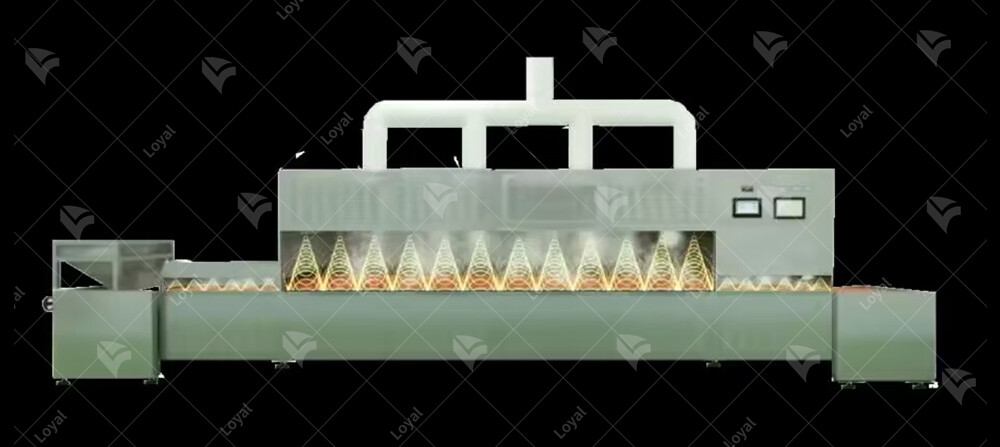
References
The following are five authoritative foreign literature websites in the field of industrial microwaves:
1. IEEE Xplore Digital Library
Website: [https://ieeexplore.ieee.org/]
2.ScienceDirect
Website: [https://www.sciencedirect.com/]
3. SpringerLink
Website: [https://link.springer.com/]
4. Wiley Online Library
Website: [https://onlinelibrary.wiley.com/]
5. PubMed
Website: [https://pubmed.ncbi.nlm.nih.gov/]
 Telephone :+86-531-55583139
Telephone :+86-531-55583139 WhatsApp :+86 13256674591
WhatsApp :+86 13256674591 Email :
Email :










